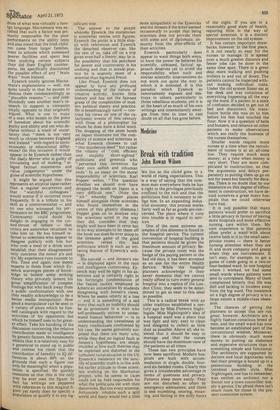Medicine
Break with tradition
John Rowan Wilson
We live so the cliche goes, in a world of rising expectations. This 'is a way of saying that the common man everywhere feels he has a right to the privileges previously confined to the rich and that the .politicians find it necessary to oblige him. In an expanding industrial economy, this process works fairly well as far as goods are concerned. The place where it runs into trouble is in regard to services.
One of the most extreme ex. amples of this dilemma is found in the hospital service. The current convention of hospital building is that patients should be given the maximum amount of privacy. Because the private room was the badge of the paying patient in the bad old days, it has been accepted as an aim for the entire Health Service. While the hospital planners acknowledge in their saner moments that we cannot really afford to turn every general hospital into a replica of the London Clinic, they seem to be determined to get as near to, this ideal as possible.
This is a radical break with an older tradition established a century ago by Miss Florence Nightingale. Miss Nightingale's idea of a hospital ward was a place that was light and airy, easy to clean and designed to collect as little dust as possible. Above all, she insisted that it should be easy to manage and that the nurses should have the maximum view of the patients at all times.
These last two principles have now been sacrificed. Modern hospitals are built with accommodation in single, double, fourand six-bedded rooms. Clearly this gives a considerable advantage in terms of quietness and privacy. Patients sleep more easily. They are not disturbed so often by emergency admissions, and there is less mumbling, snoring, moaning and farting in the stilly hours of the night. If you are in a reasonably good state of health, requiring little in the way of special attention, it is a distinct improvement on the old system.
It has certain important drawbacks, however. In the first place, it is not nearly so easy for the nurses to manage. It is spread over a much greater distance and fewer jobs can be done in the same time span. There is a great deal more walking and pushing trolleys in and out of doors. The patients cannot be inspected without making individual visits. Under the old system Sister sat at her desk and was conscious of everything happening all the way up the ward. If a patient in a state of confusion decided to get out of bed and disconnect his transfusion bottle she was on to him before his feet had touched the floor. Now it is a question of bells and buzzers, and reliance on other patients to make observations which are really the business of the nurses themselves.
Smaller wards require more nurses at a time when the recruitment of nurses is at an all-time low. They require much more money, at a time when money is very short. They are more complicated in construction, so that the arguments and delays preparatory to putting them up go on not for years but literally for decades. There is no doubt that by our insistence on this degree of refinement in construction, we have denied ourselves a great many hospitals that we could otherwise 'have had.
It is just possible thdt many patients would prefer to sacrifice a little privacy in favour of having, more hospitals and more effective nursing care within them. My own experience is that patients often prefer a ward with about twelve beds in it to the small semi private rooms — there is better nursing attention when they are ill and more company and gossip when they are convalescent. It isn't easy, for example, to get a game of cards going in a two-or four-bedded ward. In one hospital where I worked, we had some small wards where patients were sent to convalesce. Many of them complained bitterly that life was dull and lacking in incident away from the big ward. The insistence on a high degree of privacy is to a large extent a middle-class obsession.
The chances of getting the planners to accept this are not great, however. Architects are a highly fashion-conscious breed of men, and the small ward has now become an established part of the conventional wisdom. Moreover, there is obviously much more money in putting up elaborate and expensive structures than in something simple and functional. The architects are supported by doctors and local dignitaries who feel their prestige is bound up in a pretentious building in the .trendiest possible style. Miss Nightingale, one has to remember, was neither an architect nor a doctor nor a town councillor; simply a genius. I'm afraid there isn't much room for those in the present committee system.


































 Previous page
Previous page